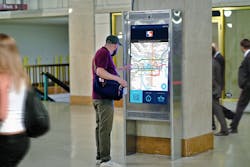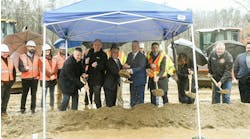Creating a Responsive Transit Experience
In rapidly changing environments like transit, real-time customer communications are critical to empowering customers with information to guide travel decisions. Historically, a lack of on-the-ground information and resources made communications difficult, but today, new digital screens and sensors, backed with machine learning technologies can make this a reality. In short, transit is becoming responsive.
Transit agencies nationwide are searching for new ways to address rising expectations of “digitally native” customers who turn to digital instead of analog maps, expect real-time service updates, and want transportation to come to them instead of waiting at a bus stop. The core of these expectations is more dynamic, relevant, responsive customer communications.
In the past, transit authorities relied on an open data-led approach that broadcast data from transit authority systems to customers via third-party apps, like CityMapper, My Transit, The Transit App and thousands of others. The experience was rarely consistent, and data flowed only in one direction, like broadcast TV or radio.
Today, transit authorities are discovering that maintaining and developing the customer relationship themselves has value. In doing so, transit agencies can engage customers in a two-way dialogue that makes them more responsive to customer needs. This means improving security with “see something say something” apps, or using mobile devices to understand aggregate passenger behavior, with the goal of designing better stations and optimizing service (i.e., Transport For London is currently testing such ‘two-way’ technologies).
We believe a two-way exchange with customers is the future of digital communications for transit. This represents a new responsive transit model that can bring value to both transit agencies and customers.
Intersection has been partnering with transit authorities to improve the customer experience of transit with new digital infrastructure, including in-station digital displays, high-speed Wi-Fi, charging stations, and real-time arrival information for over a decade. The premise behind our approach is simple: by improving the public transit customer experience, we create a more attractive public place. One where customers want to travel, advertisers reach more audiences, and transit authority partners operate at their best. Increasingly, our partnerships with TAs are moving into the realm of customer communications.
By utilizing machine learning, sensors, and other IoT infrastructure and digital screens, we are able to get the right message to the right audience at the right time. By generating data that helps transit agencies understand the on-the-ground, real-time status of their transit systems, we make it possible for transit agencies to respond to customer needs. Only recently has it become possible to integrate such digital infrastructure in a fast moving feedback loop, pushing messages out to customers and pulling data in from sensors and users themselves.
At Intersection, we’re delivering on the first phase of responsive smart transit with our On-The-Go kiosks, 231 of which are deployed throughout New York City’s Metropolitan Transit Authority (MTA) subway stations. On-The-Go provides a combination of interactive wayfinding, service changes, and real time arrivals customized to the station or platform where the kiosk is installed, all on a 55” touch screen.
Additionally, customers can access content and information from Twitter and other social feeds that are operated directly by the transit agency, giving them an additional source of information and context in which to make travel decisions.
Like our award-winning Link product deployed in New York City, On-The-Go provides a mix of real time information, all of it contextually relevant to the customer. This includes information from our content partners, Intersection’s own internal content team, advertisers, and the transit authority itself. From these sources, customers see a mix of weather reports, real time arrival information, service status from Twitter, interactive maps and more.
In many ways, On-The-Go operates much like a social media feed such as Facebook, Instagram, or Twitter. All these platforms feature endless real-time, customized feeds of content and information, designed to be relevant to the individuals who view them. On-The-Go takes an analogous approach, but in a physical form, and one designed specially for transit customers.
Much of the content on social media platforms, however, is produced by humans. Often, humans are not able to respond efficiently and effectively to rapidly changing conditions and environments. Fortunately, in our Internet of Things-enabled world, we can begin to automate some of this work. By leveraging anonymized and aggregated data from a combination of sensors and customers themselves, TAs can better understand on the ground conditions and generate a response automatically.
Machines have already accelerated the speed of business across of number of industries. Companies specializing in everything from securities trading to online media buying have all seen their operations accelerate to the pace of milliseconds, all driven by algorithms. Soon, it will be possible for machines to generate transit kiosk content at similar speeds. It’s already in the works: from text-based dialog (“conversational commerce”) to speech-based interfaces like Google Home or Alexa, machines are already mimicking human conversation, doing it quickly, and with considerable acceptance and utility.
The future of digital customer communications in transit will require humans and machines to work together, both taking in information and responding to that data in kind. In the near term, machine learning algorithms can exist alongside humans, helping us craft messages and content that will get customers to their destinations quickly and safely. The algorithms can be fed with Twitter content, data from dispatch systems and real time arrival systems, as well as input from smartphone apps and other sources. Measurement and sensing will be enabled by IoT infrastructure; content curated and targeted to screens by machine learning algorithms.
Looking farther into the future, machines will generate their own messages. Trained by humans over the years to communicate the right kinds of things, the algorithms will take IoT inputs and write their own service alerts and customer messages, targeting them to the screens--in station or in hands--where they will reach the most relevant audience within seconds, helping customers avoid wasting time and getting to their destinations faster.
Digital screens with sensors, machine learning algorithms, and other responsive technologies will enable transit authorities to deliver targeted information in real-time to customers, improving the experience of transit by empowering customers with the information they need in order to make informed travel decisions.
Intersection’s digital signage “Wiring Up the Big Apple with LinkNYC” installation on behalf of New York City was recognized with a Silver APEX Award in the Public Spaces category. More than 7,500 payphones across New York City were replaced with structures offering free gigabit Wi-Fi and digital services, paid for by advertising. DSE’s YouTube.com site. For more information on digital signage see http://www.digitalsignageexpo.net
Jeff Maki, urban strategist for Intersection helps organizations working at urban scale deploy technology to improve customer experience and operational outcomes. He is especially interested in public-private partnerships, the role of the arts and culture in placemaking, and new approaches to service delivery, particularly transportation and government. Past clients include New York City Transit (MTA), NASA’s Ames Research Center, The White House Office of Science and Technology Policy, The Commonwealth of Pennsylvania, The City of New York, and others. Before joining Intersection, Jeff was a Director at the nonprofit, OpenPlans, where he led a team of designers and developers consulting on transformative technology for the public sector. Jeff holds a Bachelor of Science in Information Systems, with a minor in Art from Carnegie Mellon University, and a Master of Information Systems Management degree from the H.J. Heinz III College of Public Policy and Management.




